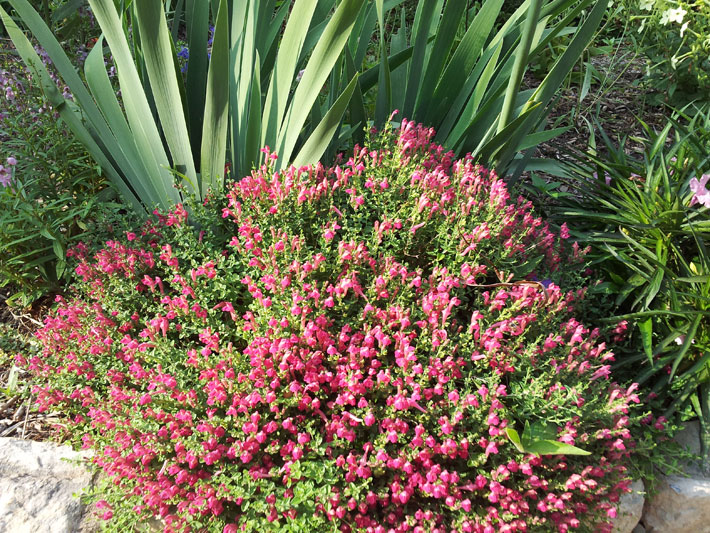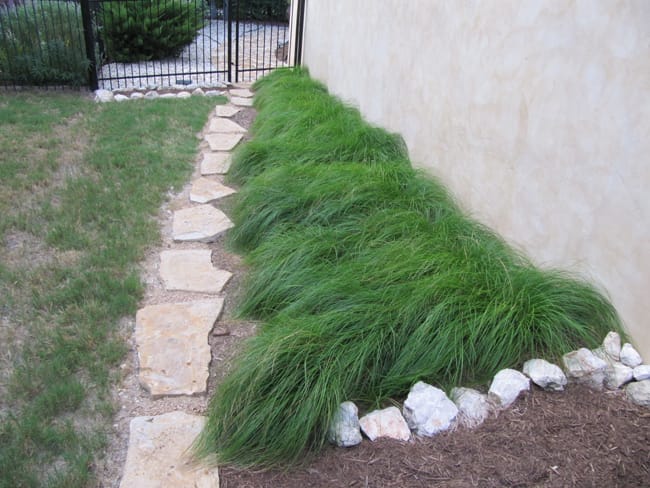Tame wild garden bed borders with these tidy, water-efficient plant selections.
Falling in love with a plant and neglecting to check its full size at maturity is an all-too-common gardening mistake. Often, the wrong placement can become an everyday annoyance when you tuck an expansive plant into a walkway border and then must trim it frequently to avoid scratches.
An overflowing cottage garden exudes coziness and abundance, but make sure to check plant tags and use a measuring tape to correctly place any new plants. Sketching your planned border to scale can help you avoid mistakes. Locate taller plants towards the back and select low-growing perennials for your borders. The best plants for a tidy border will be one to two feet tall and wide.
Edgy ideas
Refresh your borders with the ideas below or browse our plant finder.
- Sun versus shade. Observe your yard throughout the day and make notes on how much sun the border in question receives, so you can select the right plant for the right place.
- Plant blooms for every season. Fall and spring are best for planting, but you can sketch out your ideas in other seasons. Note the bloom time on your sketch, so you can ensure year-round color.
- Consult a color wheel to help create a color scheme and set the mood for your garden.
- Mass plantings of one species can create a beautiful, simplistic flow or you can repeat groupings with odd numbers of plants for more visual interest.
- Consider contrasting textures. Combine finely textured leaves or flowers with larger, coarser ones for a striking contrast.
- Spikes and mounds. Soften the edges of a pathway or hardscape with low, mounding plants interspersed with selections that stand out with their long, thin leaves.
Sun-kissed borders
Frame your beds in bright sun with these options.

- Mexican skullcap. With tiny leaves and pink flowers, this mounding skullcap makes a great border plant.
- Wright’s skullcap. This evergreen Central Texas native offers purple blooms in spring to lure in pollinators.
- Bulbine. Perfect for sunny areas, the small orange and yellow blossoms rise over a bunched base.
- Society garlic. This well-behaved border plant with lovely lavender flowers and evergreen leaves prefers sun with a bit of afternoon shade.
- Damianita. Tiny yellow flowers burst out above its evergreen leaves April to July, attracting pollinators.
- Ruby grass. A beautiful bunch of blue-green leaves topped by feathery, pink flowers in late summer.
- Thyme. A drought-tolerant, evergreen herb that attracts bees.
- Oregano. You can nibble this kitchen garden favorite which grows up to three feet tall.
Get shady
Let these plant selections lead the eye through your shaded landscapes.
- Texas sedge. Bunches of this native sedge create casually elegant edges topping out around 10 inches in height.
- Cedar sage. Native to Central Texas, this small beauty boasts charming, scalloped leaves and bright red flowers that will be attended by hummingbirds, bees and other pollinators.
 Purple oxalis. Delightful purple shamrocks with delicate pink flowers add color to shade gardens — and stay nicely in place.
Purple oxalis. Delightful purple shamrocks with delicate pink flowers add color to shade gardens — and stay nicely in place.- Spider plant. Long, gracefully cascading leaves spill from low, mounding rosettes. Adorable plantlets grow from stems and can be potted or planted.
- Aztec grass. Small, dense clumps with arching variegated leaves make it easy to fill a border.
- If you have a little more spacious border in the shade, liriope’s lily-like leaves will fill in an area up to three feet wide.
- Flax lily. Adorn shady borders with this foliage star, known for its strappy and often variegated leaves. Another plant for larger borders.
Surround your landscape with the perfect border plants for a more harmonious and polished look.


